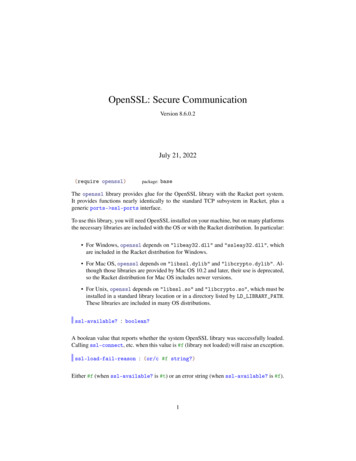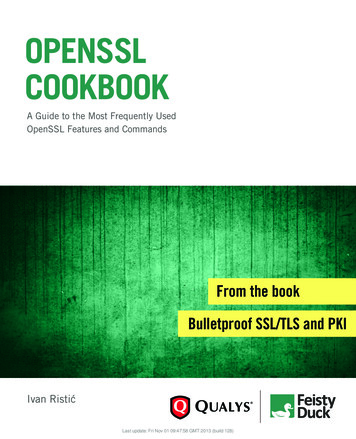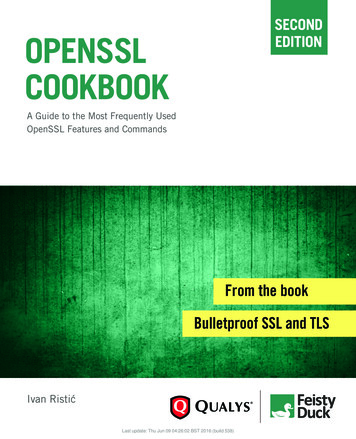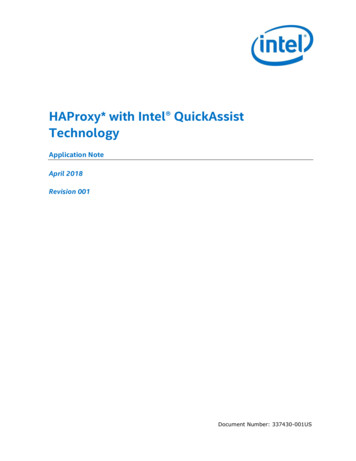
Transcription
OpenSSL: Secure CommunicationVersion 8.6.0.2July 21, 2022(require openssl)package:baseThe openssl library provides glue for the OpenSSL library with the Racket port system.It provides functions nearly identically to the standard TCP subsystem in Racket, plus ageneric ports- ssl-ports interface.To use this library, you will need OpenSSL installed on your machine, but on many platformsthe necessary libraries are included with the OS or with the Racket distribution. In particular: For Windows, openssl depends on "libeay32.dll" and "ssleay32.dll", whichare included in the Racket distribution for Windows. For Mac OS, openssl depends on "libssl.dylib" and "libcrypto.dylib". Although those libraries are provided by Mac OS 10.2 and later, their use is deprecated,so the Racket distribution for Mac OS includes newer versions. For Unix, openssl depends on "libssl.so" and "libcrypto.so", which must beinstalled in a standard library location or in a directory listed by LD LIBRARY PATH.These libraries are included in many OS distributions.ssl-available? : boolean?A boolean value that reports whether the system OpenSSL library was successfully loaded.Calling ssl-connect, etc. when this value is #f (library not loaded) will raise an exception.ssl-load-fail-reason : (or/c #f string?)Either #f (when ssl-available? is #t) or an error string (when ssl-available? is #f).1
1TCP-like Client ProceduresUse ssl-connect or ssl-connect/enable-break to create an SSL connection over TCP.To create a secure connection, supply the result of ssl-secure-client-context or create a client context with ssl-make-client-context and configure it using the functionsdescribed in §4 “Context Procedures”.(ssl-connect hostnameport-no[client-protocol#:alpn alpn-protocols ]) Ñ input-port? output-port?hostname : string?port-no : (integer-in 1 65535)client-protocol : (or/c ssl-client-context?'secure'auto'sslv2-or-v3 'sslv2 'sslv3 'tls 'tls11 'tls12) 'autoalpn-protocols : (listof bytes?) nullConnect to the host given by hostname , on the port given by port-no . This connectionwill be encrypted using SSL. The return values are as for tcp-connect: an input port andan output port.The default 'auto protocol is insecure. Use 'secure for a secure connection. See sslsecure-client-context for details.The optional client-protocol argument determines which encryption protocol is used,whether the server’s certificate is checked, etc. The argument can be either a client contextcreated by ssl-make-client-context a symbol specifying the protocol to use; see sslmake-client-context for further details, including the meanings of the protocol symbols.Closing the resulting output port does not send a shutdown message to the server. See alsoports- ssl-ports.If hostname verification is enabled (see ssl-set-verify-hostname!), the peer’s certificate is checked against hostname .If alpn-protocols is not empty, the client attempts to use ALPN to negotiate theapplication-level protocol. The protocols should be listed in order of preference, and eachprotocol must be a byte string with a length between 1 and 255 (inclusive). See also sslget-alpn-selected.Changed in version 6.3.0.12 of package base: Added 'secure for client-protocol .Changed in version 8.0.0.13: Added #:alpn argument.2
(ssl-connect/enable-break hostnameport-no[client-protocol ])Ñ input-port? output-port?hostname : string?port-no : (integer-in 1 65535)client-protocol : (or/c ssl-client-context?'secure 'auto'sslv2-or-v3 'sslv2 'sslv3 'tls 'tls11 'tls12) 'autoLike ssl-connect, but breaking is enabled while trying to connect.(ssl-secure-client-context) Ñ ssl-client-context?Returns a client context that verifies certificates using the default verification sources from(ssl-default-verify-sources), verifies hostnames, and avoids using weak ciphers.The result is essentially equivalent to the following:(let ([ctx (ssl-make-client-context 'auto)]); Load default verification sources (root certificates)(ssl-load-default-verify-sources! ctx); Require certificate verification(ssl-set-verify! ctx #t); Require hostname verification(ssl-set-verify-hostname! ctx #t); No weak cipher suites(ssl-set-ciphers! ctx "DEFAULT:!aNULL:!eNULL:!LOW:!EXPORT:!SSLv2"); Seal context so further changes cannot weaken it(ssl-seal-context! ctx)ctx)The context is cached, so different calls to ssl-secure-client-context return the samecontext unless (ssl-default-verify-sources) has changed.Note that (ssl-secure-client-context) returns a sealed context, so it is not possibleto add a private key and certificate chain to it. If client credentials are required, use sslmake-client-context -key private-key#:certificate-chain certificate-chain ])Ñ ssl-client-context?protocol : (or/c 'secure 'auto'sslv2-or-v3 'sslv2 'sslv3 'tls 'tls11 'tls12) 'auto3
private-key : (or/c (list/c 'pem path-string?) #f(list/c 'der path-string?)#f)certificate-chain : (or/c path-string? #f) #fCreates a context to be supplied to ssl-connect. The context is insecure unless 'secureis supplied or additional steps are taken; see ssl-secure-client-context for details.The client context identifies a communication protocol (as selected by protocol ), and alsoholds certificate information (i.e., the client’s identity, its trusted certificate authorities, etc.).See the section §4 “Context Procedures” below for more information on certificates.The protocol should be one of the following: 'secure : Equivalent to (ssl-secure-client-context). 'auto : Automatically negotiates the protocol version from those that this libraryconsiders sufficiently secure—currently TLS versions 1.0 and higher, but subject tochange. 'tls12 : Only TLS protocol version 1.2.Note that later TLS versions are supported, but there is no corresponding protocol symbol; using 'secure is best and forward-compatible. The following protocol symbols aredeprecated but still supported: 'sslv2-or-v3 : Alias for 'auto. Note that despite the name, neither SSL 2.0 nor 3.0are considered sufficiently secure, so this protocol no longer allows either of them. 'sslv2 : SSL protocol version 2.0. Insecure. Note that SSL 2.0 support has beenremoved from many platforms. 'sslv3 : SSL protocol version 3.0. Insecure. 'tls : Only TLS protocol version 1.0. 'tls11 : Only TLS protocol version 1.1.Not all protocol versions are supported by all servers. The 'secure and 'auto options offerbroad compatibility at a reasonable level of security. Note that the security of connectionsdepends on more than the protocol version; see ssl-secure-client-context for details.See also supported-client-protocols and supported-server-protocols.If private-key and certificate-chain are provided, they are loaded into the context using ssl-load-private-key! and ssl-load-certificate-chain!, respectively.4
Client credentials are rarely used with HTTPS, but they are occasionally used in other kindof servers.Changed in version 6.1 of package base: Added 'tls11 and 'tls12.Changed in version 6.1.1.3: Default to new 'auto and disabled SSL 2.0 and 3.0 by default.Changed in version 6.3.0.12: Added 'secure.Changed in version 7.3.0.10: Added #:private-key and #:certificate-chain arguments.(supported-client-protocols)Ñ (listof (or/c 'secure 'auto'sslv2-or-v3 'sslv2 'sslv3 'tls 'tls11 'tls12))Returns a list of symbols representing protocols that are supported for clients on the currentplatform.Changed in version 6.3.0.12 of package base: Added 'secure.(ssl-client-context? v ) Ñ boolean?v : any/cReturns #t if v is a value produced by ssl-make-client-context, #f otherwise.Added in version 6.0.1.3 of package base.(ssl-max-client-protocol)Ñ (or/c 'sslv2 'sslv3 'tls 'tls11 'tls12 #f)Returns the most recent SSL/TLS protocol version supported by the current platform forclient connections.Added in version 6.1.1.3 of package base.5
2TCP-like Server Procedures(ssl-listen port-no[queue-kreuse?hostname-or-#fserver-protocol ]) Ñ ssl-listener?port-no : listen-port-number?queue-k : exact-nonnegative-integer? 5reuse? : any/c #fhostname-or-#f : (or/c string? #f) #fserver-protocol : (or/c ssl-server-context?'secure 'auto'sslv2-or-v3 'sslv2 'sslv3 'tls 'tls11 'tls12) 'autoLike tcp-listen, but the result is an SSL listener. The extra optional server-protocolis as for ssl-connect, except that a context must be a server context instead of a clientcontext, and 'secure is simply an alias for 'auto.Call ssl-load-certificate-chain! and ssl-load-private-key! to avoid a noshared cipher error on accepting connections. The file "test.pem" in the "openssl" collection is a suitable argument for both calls when testing. Since "test.pem" is public,however, such a test configuration obviously provides no security.An SSL listener is a synchronizable value (see sync). It is ready—with itself as its value—when the underlying TCP listener is ready. At that point, however, accepting a connectionwith ssl-accept may not complete immediately, because further communication is neededto establish the connection.Changed in version 6.3.0.12 of package base: Added 'secure.(ssl-close listener ) Ñ void?listener : ssl-listener?(ssl-listener? v ) Ñ boolean?v : any/cAnalogous to tcp-close and tcp-listener?.(ssl-accept listener ) Ñ input-port? output-port?listener : ssl-listener?(ssl-accept/enable-break listener ) Ñ input-port? output-port?listener : ssl-listener?Analogous to tcp-accept.6
Closing the resulting output port does not send a shutdown message to the client. See alsoports- ssl-ports.See also ssl-connect about the limitations of reading and writing to an SSL connection(i.e., one direction at a time).The ssl-accept/enable-break procedure is analogous to tcp-accept/enable-break.(ssl-abandon-port p ) Ñ void?p : ssl-port?Analogous to tcp-abandon-port.(ssl-addresses p [port-numbers?])Ñ (or/c (values string? string?)(values string? port-number? string? listen-port-number?))p : (or/c ssl-port? ssl-listener?)port-numbers? : any/c #fAnalogous to tcp-addresses.(ssl-port? v ) Ñ boolean?v : any/cReturns #t of v is an SSL port produced by ssl-connect, ssl-connect/enable-break,ssl-accept, ssl-accept/enable-break, or ports- te-key private-key#:certificate-chain certificate-chain ])Ñ ssl-server-context?protocol : (or/c 'secure 'auto'sslv2-or-v3 'sslv2 'sslv3 'tls 'tls11 'tls12) 'autoprivate-key : (or/c (list/c 'pem path-string?) #f(list/c 'der path-string?)#f)certificate-chain : (or/c path-string? #f) #fLike ssl-make-client-context, but creates a server context. For a server context, the'secure protocol is the same as 'auto.If private-key and certificate-chain are provided, they are loaded into the contextusing ssl-load-private-key! and ssl-load-certificate-chain!, respectively.7
Changed in version 6.3.0.12 of package base: Added 'secure.Changed in version 7.3.0.10: Added #:private-key and #:certificate-chain arguments.(ssl-server-context? v ) Ñ boolean?v : any/cReturns #t if v is a value produced by ssl-make-server-context, #f otherwise.(supported-server-protocols)Ñ (listof (or/c 'secure 'auto'sslv2-or-v3 'sslv2 'sslv3 'tls 'tls11 'tls12))Returns a list of symbols representing protocols that are supported for servers on the currentplatform.Added in version 6.0.1.3 of package base.Changed in version 6.3.0.12: Added 'secure.(ssl-max-server-protocol)Ñ (or/c 'sslv2 'sslv3 'tls 'tls11 'tls12 #f)Returns the most recent SSL/TLS protocol version supported by the current platform forserver connections.Added in version 6.1.1.3 of package base.8
3SSL-wrapper Interface(ports- ssl-ports input-portoutput-port[#:mode mode#:context context#:encrypt protocol#:close-original? close-original?#:shutdown-on-close? shutdown-on-close?#:error/ssl error#:hostname hostname#:alpn alpn-protocols ])Ñ input-port? output-port?input-port : input-port?output-port : output-port?mode : (or/c 'connect 'accept) 'acceptcontext : (or/c ssl-client-context? ssl-server-context?) ((if (eq? mode text)protocol )protocol : (or/c 'secure 'auto'sslv2-or-v3 'sslv2 'sslv3 'tls 'tls11 'tls12) 'autoclose-original? : boolean? #fshutdown-on-close? : boolean? #ferror : procedure? errorhostname : (or/c string? #f) #falpn-protocols : (listof bytes?) nullReturns two values—an input port and an output port—that implement the SSL protocol overthe given input and output port. (The given ports should be connected to another process thatruns the SSL protocol.)The mode argument can be 'connect or 'accept. The mode determines how the SSLprotocol is initialized over the ports, either as a client or as a server. As with ssl-listen, in'accept mode, supply a context that has been initialized with ssl-load-certificatechain! and ssl-load-private-key! to avoid a no shared cipher error.The context argument should be a client context for 'connect mode or a server contextfor 'accept mode. If it is not supplied, a context is created using the protocol specified bya protocol argument.If the protocol argument is not supplied, it defaults to 'auto. See ssl-make-clientcontext for further details (including all options and the meanings of the protocol symbols).This argument is ignored if a context argument is supplied.9
If close-original? is true, then when both SSL ports are closed, the given input andoutput ports are automatically closed.If shutdown-on-close? is true, then when the output SSL port is closed, it sends a shutdown message to the other end of the SSL connection. When shutdown is enabled, closingthe output port can fail if the given output port becomes unwritable (e.g., because the otherend of the given port has been closed by another process).The error argument is an error procedure to use for raising communication errors. Thedefault is error , which raises exn:fail; in contrast, ssl-accept and ssl-connect usean error function that raises exn:fail:network.See also ssl-connect about the limitations of reading and writing to an SSL connection(i.e., one direction at a time).If hostname verification is enabled (see ssl-set-verify-hostname!), the peer’s certificate is checked against hostname .If alpn-protocols is not empty and mode is 'connect, then the client attempts to useALPN; see also ssl-connect and ssl-get-alpn-selected. If alpn-protocols is notempty and mode is 'accept, an exception (exn:fail) is raised; use ssl-set-serveralpn! to set the ALPN protocols for a server context.Changed in version 8.0.0.13 of package base: Added #:alpn argument.10
4Context Procedures(ssl-load-verify-source! contextsrc[#:try? try?]) Ñ void?context : (or/c ssl-client-context? ssl-server-context?)src : (or/c path-string?(list/c 'directory path-string?)(list/c 'win32-store string?)(list/c 'macosx-keychain (or/c #f path-string?)))try? : any/c #fLoads verification sources from src into context . Currently, only certificates are loaded;the certificates are used to verify the certificates of a connection peer. Call this proceduremultiple times to load multiple sets of trusted certificates.The following kinds of verification sources are supported: If src is a path or string, it is treated as a PEM file containing root certificates. Thefile is loaded immediately. If src is (list 'directory dir ), then dir should contain PEM files with hashedsymbolic links (see the openssl c rehash utility). The directory contents are notloaded immediately; rather, they are searched only when a certificate needs verification. If src is (list 'win32-store store ), then the certificates from the store namedstore are loaded immediately. Only supported on Windows. If src is (list 'macosx-keychain #f), then the certificates from the Mac OStrust anchor (root) certificates (as returned by SecTrustCopyAnchorCertificates)are loaded immediately. Only supported on Mac OS. If src is (list 'macosx-keychain path ), then the certificates from the keychainstored at path are loaded immediately. Only supported on Mac OS.If try? is #f and loading src fails (for example, because the file or directory does not exist),then an exception is raised. If try? is a true value, then a load failure is ignored.You can use the file "test.pem" of the "openssl" collection for testing purposes. Since"test.pem" is public, such a test configuration obviously provides no security.Changed in version 8.4.0.5 of package base: Added (list 'macosx-keychain #f) variant.(ssl-default-verify-sources)11
Ñ (let ([source/c (or/c path-string?(list/c 'directory path-string?)(list/c 'win32-store string?)(list/c 'macosx-keychain (or/c #f path-string?)))])(listof source/c))(ssl-default-verify-sources srcs ) Ñ void?srcs : (let ([source/c (or/c path-string?(list/c 'directory path-string?)(list/c 'win32-store string?)(list/c 'macosx-keychain (or/c #f path-string?)))])(listof source/c))Holds a list of verification sources, used by ssl-load-default-verify-sources!. Thedefault sources depend on the platform: On Linux, the default sources are determined by the SSL CERT FILE andSSL CERT DIR environment variables, if the variables are set, or the system-widedefault locations otherwise. On Mac OS, the default sources consist of the OS trust anchor (root) certificates:'(macosx-keychain #f). On Windows, the default sources consist of the system certificate store for root certificates: '(win32-store "ROOT").Changed in version 8.4.0.5 of package base: Changed default source on Mac OS.(ssl-load-default-verify-sources! context ) Ñ void?context : (or/c ssl-client-context? ssl-server-context?)Loads the default verification sources, as determined by (ssl-default-verifysources), into context . Load failures are ignored, since some default sources may referto nonexistent paths.(ssl-load-verify-root-certificates! context-or-listenerpathname )Ñ void?context-or-listener : (or/c ssl-client-conntext? ssl-server-context?ssl-listener?)pathname : path-string?Deprecated; like ssl-load-verify-source!, but only supports loading certificate files inPEM format.(ssl-set-ciphers! context cipher-spec ) Ñ void?context : (or/c ssl-client-context? ssl-server-context?)cipher-spec : string?12
Specifies the cipher suites that can be used in connections created with context . The meaning of cipher-spec is the same as for the openssl ciphers command.(ssl-seal-context! context ) Ñ void?context : (or/c ssl-client-context? ssl-server-context?)Seals context , preventing further modifications. After a context is sealed, passing it tofunctions such as ssl-set-verify! and ssl-load-verify-root-certificates! results in an error.(ssl-load-certificate-chain! context-or-listenerpathname )Ñ void?context-or-listener : (or/c ssl-client-context? ssl-server-context?ssl-listener?)pathname : path-string?Loads a PEM-format certification chain file for connections to made with the given servercontext (created by ssl-make-server-context) or listener (created by ssl-listen). Acertificate chain can also be loaded into a client context (created by ssl-make-clientcontext) when connecting to a server requiring client credentials, but that situation is uncommon.This chain is used to identify the client or server when it connects or accepts connections.Loading a chain overwrites the old chain. Also call ssl-load-private-key! to load thecertificate’s corresponding key.You can use the file "test.pem" of the "openssl" collection for testing purposes. Since"test.pem" is public, such a test configuration obviously provides no security.(ssl-load-private-key! context-or-listenerpathname[rsa?asn1?])Ñ void?context-or-listener : (or/c ssl-client-context? ssl-server-context?ssl-listener?)pathname : path-string?rsa? : boolean? #tasn1? : boolean? #fLoads the first private key from pathname for the given context or listener. The key goeswith the certificate that identifies the client or server. Like ssl-load-certificatechain!, this procedure is usually used with server contexts or listeners, seldom with clientcontexts.If rsa? is #t (the default), the first RSA key is read (i.e., non-RSA keys are skipped). Ifasn1? is #t, the file is parsed as ASN1 format instead of PEM.13
You can use the file "test.pem" of the "openssl" collection for testing purposes. Since"test.pem" is public, such a test configuration obviously provides no es!context-or-listenerpathname )Ñ void?context-or-listener : (or/c ssl-client-context? ssl-server-context?ssl-listener?)pathname : path-string?Loads a PEM-format file containing certificates that are used by a server. The certificate listis sent to a client when the server requests a certificate as an indication of which certificatesthe server trusts.Loading the suggested certificates does not imply trust, however; any certificate presentedby the client will be checked using the trusted roots loaded by ssl-load-verify-rootcertificates!.You can use the file "test.pem" of the "openssl" collection for testing purposes wherethe peer identifies itself using "test.pem".(ssl-server-context-enable-dhe! context[dh-param ]) Ñ void?context : ssl-server-context?dh-param : (or/c path-string? bytes?) cdhe! context[curve-name ]) Ñ void?context : ssl-server-context?curve-name : symbol? 'secp521r1Enables cipher suites that provide perfect forward secrecy via ephemeral Diffie-Hellman(DHE) or ephemeral elliptic-curve Diffie-Hellman (ECDHE) key exchange, respectively.For DHE, the dh-param must be a path to a ".pem" file containing DH parameters or thecontent of such a file as a byte string.For ECDHE, the curve-name must be one of the following symbols naming a standard elliptic curve: 'sect163k1, 'sect163r1, 'sect163r2, 'sect193r1, 'sect193r2,'sect233k1, 'sect233r1, 'sect239k1, 'sect283k1, 'sect283r1, 'sect409k1,'sect409r1, 'sect571k1, 'sect571r1, 'secp160k1, 'secp160r1, 'secp160r2,'secp192k1, 'secp224k1, 'secp224r1, 'secp256k1, 'secp384r1, 'secp521r1,'prime192v, 'prime256v.Changed in version 7.7.0.4 of package base:ssl-server-context-enable-dhe!.Allow a byte string as the dh-param argument to14
ssl-dh4096-param-bytes : bytes?Byte string describing 4096-bit Diffie-Hellman parameters in ".pem" format.Changed in version 7.7.0.4 of package base: Added as a replacement for ication-callback! contextcallback ) Ñ void?context : ssl-server-context?callback : (string? . - . (or/c ssl-server-context? #f))Provides an SSL server context with a procedure it can use for switching to alternative contexts on a per-connection basis. The procedure is given the hostname the client was attempting to connect to, to use as the basis for its decision.The client sends this information via the TLS Server Name Identification extension, whichwas created to allow virtual hosting for secure servers.The suggested use it to prepare the appropriate server contexts, define a single callbackwhich can dispatch between them, and then apply it to all the contexts before sealing them.A minimal example:(define ctx-a (ssl-make-server-context 'tls))(define ctx-b (ssl-make-server-context 'tls)).(ssl-load-certificate-chain! ctx-a "cert-a.pem")(ssl-load-certificate-chain! ctx-b "cert-b.pem").(ssl-load-private-key! ctx-a "key-a.pem")(ssl-load-private-key! ctx-b "key-b.pem").(define (callback hostname)(cond [(equal? hostname "a") ctx-a][(equal? hostname "b") ctx-b].[else #f]))(ssl-set-server-name-identification-callback! ctx-a callback )(ssl-set-server-name-identification-callback! ctx-b callback ).(ssl-seal-context! ctx-a)(ssl-seal-context! ctx-b).(ssl-listen 443 5 #t #f ctx-a)If the callback returns #f, the connection attempt will continue, using the original servercontext.15
(ssl-set-server-alpn! contextalpn-protocols[allow-no-match?]) Ñ void?context : ssl-server-context?alpn-protocols : (listof bytes?)allow-no-match? : boolean? #tSets the ALPN protocols supported by the server context. The protocols are listed in orderof preference, most-preferred first. That is, when a client connects, the server selects thefirst protocol in its alpn-protocols that is supported by the client. If the client does notuse ALPN, then the connection is accepted and no protocol is selected. If the client usesALPN but has no protocols in common with the server, then if allow-no-match? is true,the connection is accepted and no protocol is selected; if allow-no-match? is false, thenthe connection is refused.Added in version 8.4.0.5 of package base.16
5Peer Verification(ssl-set-verify! clp on?) Ñ void?clp : (or/c ssl-client-context? ssl-server-context?ssl-listener? ssl-port?)on? : any/cRequires certificate verification on the peer SSL connection when on? is #t. If clp is an SSLport, then the connection is immediately renegotiated, and an exception is raised immediatelyif certificate verification fails. If clp is a context or listener, certification verification happenson each subsequent connection using the context or listener.Enabling verification also requires, at a minimum, designating trusted certificate authoritieswith ssl-load-verify-source!.Verifying the certificate is not sufficient to prevent attacks by active adversaries, such asman-in-the-middle attacks. See also ssl-set-verify-hostname!.(ssl-try-verify! clp on?) Ñ void?clp : (or/c ssl-client-context? ssl-server-context?ssl-listener? ssl-port?)on? : any/cLike ssl-set-verify!, but when peer certificate verification fails, then connection continues to work. Use ssl-peer-verified? to determine whether verification succeeded.(ssl-peer-verified? p ) Ñ boolean?p : ssl-port?Returns #t if the peer of SSL port p has presented a valid and verified certificate, #f otherwise.(ssl-set-verify-hostname! ctx on?) Ñ void?ctx : (or/c ssl-client-context? ssl-server-context?)on? : any/cRequires hostname verification of SSL peers of connections made using ctx when on? is#t. When hostname verification is enabled, the hostname associated with a connection (seessl-connect or ports- ssl-ports) is checked against the hostnames listed in the peer’scertificate. If the peer certificate does not contain an entry matching the hostname, or if thepeer does not present a certificate, the connection is rejected and an exception is raised.Hostname verification does not imply certificate verification. To verify the certificate itself,also call ssl-set-verify!.17
(ssl-peer-certificate-hostnames p ) Ñ (listof string?)p : ssl-port?Returns the list of hostnames for which the certificate of p ’s peer is valid according to RFC2818. If the peer has not presented a certificate, '() is returned.The result list may contain both hostnames such as "www.racket-lang.org" and hostname patterns such as "*.racket-lang.org".(ssl-peer-check-hostname p hostname ) Ñ boolean?p : ssl-port?hostname : string?Returns #t if the peer certificate of p is valid for hostname according to RFC 2818.(ssl-peer-subject-name p ) Ñ (or/c bytes? #f)p : ssl-port?If ssl-peer-verified? would return #t for p , the result is a byte string for the subjectfield of the certificate presented by the SSL port’s peer, otherwise the result is #f.Use ssl-peer-check-hostname or ssl-peer-certificate-hostnames instead tocheck the validity of an SSL connection.(ssl-peer-issuer-name p ) Ñ (or/c bytes? #f)p : ssl-port?If ssl-peer-verified? would return #t for p , the result is a byte string for the issuer fieldof the certificate presented by the SSL port’s peer, otherwise the result is #f.(ssl-channel-binding p type ) Ñ bytes?p : ssl-port?type : (or/c 'tls-unique 'tls-server-end-point)Returns channel binding information for the TLS connection of p . An authentication protocol run over TLS can incorporate information identifying the TLS connection ('tlsunique) or server certificate ('tls-server-end-point) into the authentication process,thus preventing the authentication steps from being replayed on another channel. Channelbinding is described in general in RFC 5056; channel binding for TLS is described in RFC5929.If the channel binding cannot be retrieved (for example, if the connection is closed), anexception is raised.Added in version 7.7.0.9 of package base.18
(ssl-get-alpn-selected p ) Ñ (or/c bytes? #f)p : ssl-port?Returns the ALPN protocol selected during negotiation, or #f if no protocol was selected.If a server does not support any of the protocols proposed by a client, it might reject theconnection or it might accept the connection without selecting an application protocol. So itis recommended to always check the selected protocol after making a connection.Added in version 8.0.0.13 of package base.19
6SHA-1 Hashing(require openssl/sha1)package:baseThe openssl/sha1 library provides a Racket wrapper for the OpenSSL library’s SHA-1hashing functions. If the OpenSSL library cannot be opened, this library logs a warning andfalls back to the implementation in file/sha1.(sha1 in ) Ñ string?in : input-port?Returns a 40-character string that represents the SHA-1 hash (in hexadecimal notation) ofthe content from in , consuming all of the input from in until an end-of-file.The sha1 function composes bytes- hex-string with sha1-bytes.(sha1-bytes in ) Ñ bytes?in : input-port?Returns a 20-byte byte string that represents the SHA-1 hash of the content from in , consuming all of the input from in until an end-of-file.The sha1-bytes function from racket/base computes the same result and is only slightlyslower.(bytes- hex-string bstr ) Ñ string?bstr : bytes?Converts the given byte string to a string representation, where each byte in bstr is converted to its two-digit hexadecimal representation in the resulting string.(hex-string- bytes str ) Ñ bytes?str : string?The inverse of bytes- hex-string.20
7MD5 Hashing(require openssl/md5)package:baseThe openssl/md5 library provides a Racket wrapper for the OpenSSL library’s MD5 hashing functions. If the OpenSSL library cannot be opened, this library logs a warning and fallsback to the implementation in file/
For Windows, openssl depends on "libeay32.dll" and "ssleay32.dll", which are included in the Racket distribution for Windows. For Mac OS, openssl depends on "libssl.dylib" and "libcrypto.dylib". Al-though those libraries are provided by Mac OS 10.2 and later, their use is deprecated, so the Racket distribution for Mac OS includes newer .









